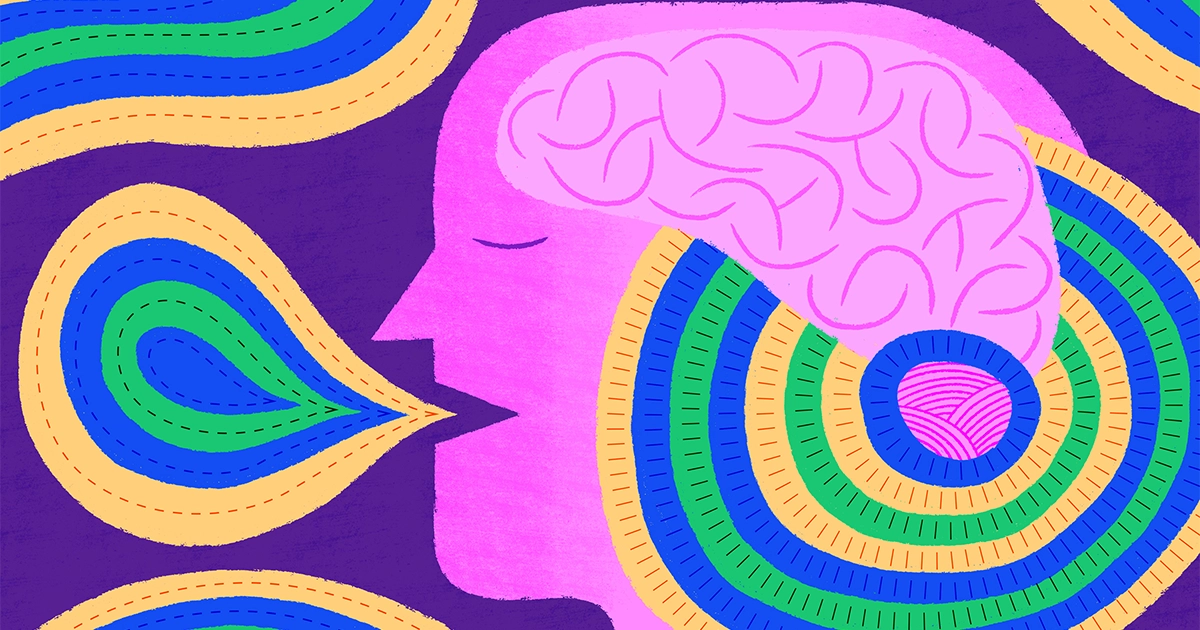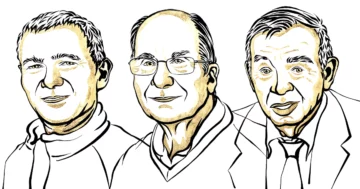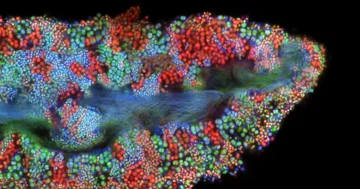
Introduction
In recent decades, neuroscience has seen some stunning advances, and yet a critical part of the brain remains a mystery. I am referring to the cerebellum, so named for the Latin for “little brain,” which is situated like a bun at the back of the brain. This is no small oversight: The cerebellum contains three-quarters of all the brain’s neurons, which are organized in an almost crystalline arrangement, in contrast to the tangled thicket of neurons found elsewhere.
Encyclopedia articles and textbooks underscore the fact that the cerebellum’s function is to control body movement. There is no question that the cerebellum has this function. But scientists now suspect that this long-standing view is myopic.
Or so I learned in November in Washington, D.C., while attending the Society for Neuroscience annual meeting, the largest meeting of neuroscientists in the world. There, a pair of neuroscientists organized a symposium on newly discovered functions of the cerebellum unrelated to motor control. New experimental techniques are showing that in addition to controlling movement, the cerebellum regulates complex behaviors, social interactions, aggression, working memory, learning, emotion and more.
A Crack in Dominant Wisdom
The connection between the cerebellum and movement has been known since the 19th century. Patients suffering trauma to the brain region had obvious difficulties with balance and movement, leaving no doubt that it was critical for coordinating motion. Over the decades, neuroscientists developed a detailed understanding of how the cerebellum’s unique neural circuitry controls motor function. The explanation of how the cerebellum worked seemed watertight.
Then, in 1998, in the journal Brain, neurologists reported on wide-ranging emotional and cognitive disabilities in patients with damage to the cerebellum. For example, in 1991, a 22-year-old female college student had fallen while ice skating; a CT scan revealed a tumor in her cerebellum. After it was removed surgically, she was a completely different person. The bright college student had lost her ability to write with proficiency, do mental arithmetic, name common objects or copy a simple diagram. Her mood flattened. She hid under covers and behaved inappropriately, undressing in the corridors and speaking in baby talk. Her social interactions, including recognizing familiar faces, were also impaired.
This and similar cases puzzled the authors. These high-level cognitive and emotional functions were understood to reside in the cerebral cortex and limbic system. “Precisely what that cerebellar role is, and how the cerebellum accomplishes it, is yet to be established,” they concluded.
Despite these clues from clinical studies that conventional wisdom was on the wrong track, leading authorities still insisted that the function of the cerebellum was to control movement and nothing more. “It is kind of sad because it has been 20 years [since these cases were reported],” said Diasynou Fioravante, a neurophysiologist at the University of California, Davis, who co-organized the conference symposium.
Other neurologists have noticed neuropsychiatric deficits in their patients all along, said the neuroscientist Stephanie Rudolph of Albert Einstein College of Medicine, who co-organized the symposium with Fioravante. However, there was no hard anatomical evidence for how the cerebellum’s unique neural circuitry could possibly regulate the reported psychological and emotional functions, so the clinical reports were overlooked.
Now, a better understanding of the cerebellum’s circuitry is proving those case studies right and dominant wisdom wrong.
Precision Wiring
The wiring pattern in the cerebellum is precisely organized and compacted to concentrate three-quarters of the brain’s neurons into a 4-inch lobe. The principal type of neuron in the cerebellum, called the Purkinje cell, is widely branching like a fan coral, yet flattened and nearly two-dimensional. The fan’s blades are the neuron’s dendrites, which receive incoming signals. These flat neurons are arranged in parallel, as if millions of fan corals were stacked atop each other in a tight bundle. Thousands of tiny neurons run axons — the brain’s transmission cables for electrical impulses — perpendicularly through the stack of dendrites, like threads in a loom. Each axon connects with the dendrites of tens of thousands of Purkinje cells.
This level of interconnectivity gives the cerebellum’s 50 billion neurons an astonishing capacity for integration. This circuitry, unique to the cerebellum, can crunch enormous amounts of incoming data from the senses to regulate body movement. The fluid movement of a ballerina leaping across the stage requires the cerebellum to rapidly process information from all senses while tracking the changing positions of limbs, maintaining balance, and mapping the space through which the body is moving. The cerebellum uses that dynamic information to control muscles with precise timing, and to do so in the right social context, driven by emotion and motivation.
Fioravante and Rudolph told me that neuroscientists are now realizing that the powerful neural circuitry in the cerebellum that integrates information for body movement also equips it to handle complex mental processes and behaviors.
“For example, right now,” Rudolph explained as we talked before the symposium began, “you ask questions, and we give answers. That is a complex behavior.” She needed to comprehend my speech, formulate a response, and then use muscles to produce words. She also had to take in my body language and other subtle signals. “You are nodding right now, for example, so from this I can conclude that you are listening and interested,” she said.
I had not fully appreciated the complexity of the motor control required for speech before. The physicality includes not only the intricate gymnastics of tongue and lips — to produce sound as well as adjust pitch and volume — but also gesticulation. Our words are timed so we don’t talk over the other person, and they are regulated for the social context: infused with the proper emotion and driven by motivation, thought, anticipation and mood.
Coordinating these diverse functions requires tapping into nearly everything the brain does — from regulation of heart rate and blood pressure, performed in deep brain regions, to the processing of sensory and emotional information, performed by the limbic system. It also requires engaging with the highest-level cognitive functions of comprehension, inhibition and decision-making in the prefrontal cerebral cortex.
For the cerebellum to do that, it would have to have connections that span the entire brain. Until now, evidence for that was lacking, but new techniques are uncovering these pathways.
A Hub of Sensory Input
Mere decades ago, when neuroanatomists mapped the brain, they couldn’t find any direct connections from the cerebellum to brain regions that control emotion and cognition, such as the limbic system and the prefrontal cortex. That led them to believe that the cerebellum was somewhat isolated and uninvolved in these higher cognitive functions. But just as bandits might evade a tracker by changing vehicles, neural signals can leap from one neuron to the next. This undercover action threw neuroanatomists off the cerebellum’s trail.
New methods have enabled neuroanatomists to trace those pathways from the cerebellum across relay points, following them across the entire brain. Researchers can, for example, plant rabies viruses in neurons to see precisely which other neurons they contact. They’ve genetically engineered fluorescent proteins to flash when a neural impulse fires so they can see the flow of traffic in neural circuits. They can also track footprints left behind by neuronal traffic: The appearance of proteins produced when a neuron fires can help identify all the cells communicating in a neural network when a specific behavior is performed.
At the symposium, researchers shared a flurry of fascinating new findings revealed by these new methods that demonstrate their evolving understanding of the cerebellum.
Jessica Verpeut of Arizona State University reported data describing the intricate and expansive network of cerebellar connections that are activated throughout the brain in mice when they socialize or learn to negotiate a maze.
Rudolph shared experiments showing that maternal behavior, studied in female mice caring for their pups, was affected by hormones acting on the cerebellum, especially the hormone oxytocin, which promotes maternal bonding. When this mechanism was disrupted experimentally, the mother no longer cared for her pups.
Yi-Mei Yang of the University of Minnesota showed that when she disrupted certain cerebellar neurons, mice lost interest in engaging with unfamiliar mice introduced into their cage. However, they had no difficulties interacting with and remembering novel inanimate objects. This indicated a deficit in complex social-recognition memory, similar to what autistic people experience.
In fact, the cerebellum is often smaller in autistic people, and Aleksandra Badura from Erasmus University Medical Center in Rotterdam presented new data suggesting that the cerebellum is involved in autism because it is a hub of sensory input, especially for signals related to social contexts.
This new research goes beyond mouse studies. Andreas Thieme from University Hospital Essen in Germany presented a new clinical test used to accurately diagnose the emotional and cognitive impairments caused by cerebellar damage.
These new, groundbreaking studies show that in addition to controlling movement, the cerebellum regulates complex social and emotional behavior. To achieve this global influence, the cerebellum must be a data-crunching hub with connections throughout the brain. No wonder it has so many neurons. To accomplish this high-order command and control on its own, it must be, in fact, a little brain.
- SEO Powered Content & PR Distribution. Get Amplified Today.
- PlatoData.Network Vertical Generative Ai. Empower Yourself. Access Here.
- PlatoAiStream. Web3 Intelligence. Knowledge Amplified. Access Here.
- PlatoESG. Carbon, CleanTech, Energy, Environment, Solar, Waste Management. Access Here.
- PlatoHealth. Biotech and Clinical Trials Intelligence. Access Here.
- Source: https://www.quantamagazine.org/the-part-of-the-brain-that-controls-movement-also-guides-feelings-20240123/
- :has
- :is
- :not
- ][p
- 1998
- 19th
- 20
- 20 years
- 50
- a
- ability
- accomplish
- accurately
- Achieve
- across
- acting
- Action
- activated
- addition
- adjust
- advances
- affected
- After
- ago
- All
- almost
- along
- also
- am
- amounts
- an
- and
- annual
- answers
- anticipation
- any
- appreciated
- ARE
- arizona
- Arizona State University
- arranged
- arrangement
- AS
- ask
- At
- attending
- Authorities
- authors
- Autism
- Autistic
- Baby
- back
- Balance
- BE
- because
- been
- before
- began
- behavior
- behaviors
- behind
- believe
- Better
- between
- Beyond
- Billion
- blood
- Blood Pressure
- body
- Brain
- Bright
- bun
- Bundle
- but
- by
- cables
- california
- called
- CAN
- Capacity
- case
- Case Studies
- cases
- caused
- cell
- Cells
- Center
- Century
- cerebral
- certain
- changing
- Clinical
- cognition
- cognitive
- College
- Common
- communicating
- completely
- complex
- complexity
- comprehend
- concentrate
- conclude
- concluded
- Conference
- connection
- Connections
- connects
- contact
- contains
- context
- contexts
- contrast
- control
- controlling
- controls
- conventional
- coordinating
- Coral
- cortex
- could
- covers
- crack
- critical
- crunch
- D.C.
- damage
- data
- Davis
- decades
- Decision Making
- deep
- DEFICIT
- demonstrate
- describing
- detailed
- developed
- diagnose
- different
- difficulties
- direct
- discovered
- diverse
- do
- does
- dominant
- Dont
- doubt
- driven
- dynamic
- each
- einstein
- elsewhere
- emotion
- emotional
- enabled
- engaging
- engineered
- enormous
- Entire
- especially
- established
- evade
- everything
- evidence
- evolving
- example
- expansive
- experience
- experimental
- experiments
- explained
- explanation
- faces
- fact
- Fallen
- familiar
- fan
- fascinating
- feelings
- female
- Find
- findings
- fires
- Flash
- flat
- flow
- fluid
- flurry
- following
- For
- found
- from
- fully
- function
- functions
- Germany
- Give
- gives
- Global
- Goes
- groundbreaking
- Guides
- had
- handle
- Hard
- Have
- Heart
- help
- her
- high-level
- higher
- Hospital
- How
- However
- HTML
- HTTPS
- Hub
- i
- ICE
- identify
- if
- in
- includes
- Including
- Incoming
- indicated
- influence
- information
- infused
- input
- Integrates
- integration
- interacting
- interactions
- interest
- interested
- into
- intricate
- introduced
- involved
- isolated
- IT
- ITS
- journal
- just
- Kind
- known
- lacking
- language
- largest
- Latin
- leading
- Leading Authorities
- Leap
- LEARN
- learned
- learning
- leaving
- Led
- left
- Level
- like
- Listening
- little
- long-standing
- longer
- loom
- lost
- magazine
- maintaining
- many
- mapping
- me
- mechanism
- medical
- medicine
- meeting
- Memory
- mental
- methods
- mice
- might
- millions
- minnesota
- mood
- more
- mother
- motion
- Motivation
- Motor
- mouse
- movement
- moving
- must
- my
- Mystery
- name
- Named
- nearly
- needed
- network
- Neural
- neural network
- neuronal
- Neurons
- Neuroscience
- New
- newly
- next
- no
- nothing
- novel
- November
- now
- objects
- obvious
- of
- off
- often
- on
- ONE
- only
- or
- Organized
- Other
- our
- over
- Oversight
- own
- pair
- Parallel
- part
- pathways
- patients
- Pattern
- People
- performed
- person
- Pitch
- plant
- plato
- Plato Data Intelligence
- PlatoData
- points
- positions
- possibly
- powerful
- precise
- precisely
- presented
- pressure
- Principal
- process
- processes
- processing
- produce
- Produced
- promotes
- proper
- Proteins
- proving
- psychological
- question
- Questions
- rapidly
- Rate
- realizing
- receive
- recent
- recognizing
- region
- regions
- Regulate
- regulated
- Regulation
- related
- remains
- remembering
- Removed
- Reported
- Reports
- required
- requires
- research
- researchers
- response
- Revealed
- right
- Role
- Run
- Said
- scan
- scientists
- see
- seemed
- seen
- shared
- she
- show
- showed
- showing
- signals
- similar
- Simple
- since
- situated
- small
- smaller
- So
- Social
- socialize
- some
- somewhat
- Sound
- Space
- span
- speaking
- specific
- speech
- stack
- stacked
- Stage
- State
- Still
- Student
- studied
- studies
- Stunning
- such
- suffering
- Symposium
- system
- Take
- Talk
- tapping
- techniques
- tens
- test
- that
- The
- the world
- their
- Them
- then
- There.
- These
- they
- this
- those
- thought
- thousands
- Through
- throughout
- Timed
- timing
- to
- told
- trace
- track
- Tracking
- traffic
- trail
- tumor
- type
- under
- underscore
- understanding
- understood
- unfamiliar
- unique
- university
- University of California
- University of Minnesota
- until
- use
- used
- uses
- Vehicles
- View
- viruses
- volume
- was
- washington
- watertight
- we
- webp
- WELL
- were
- What
- when
- which
- while
- WHO
- widely
- wisdom
- with
- wonder
- words
- worked
- working
- world
- would
- write
- Wrong
- years
- yet
- you
- zephyrnet











